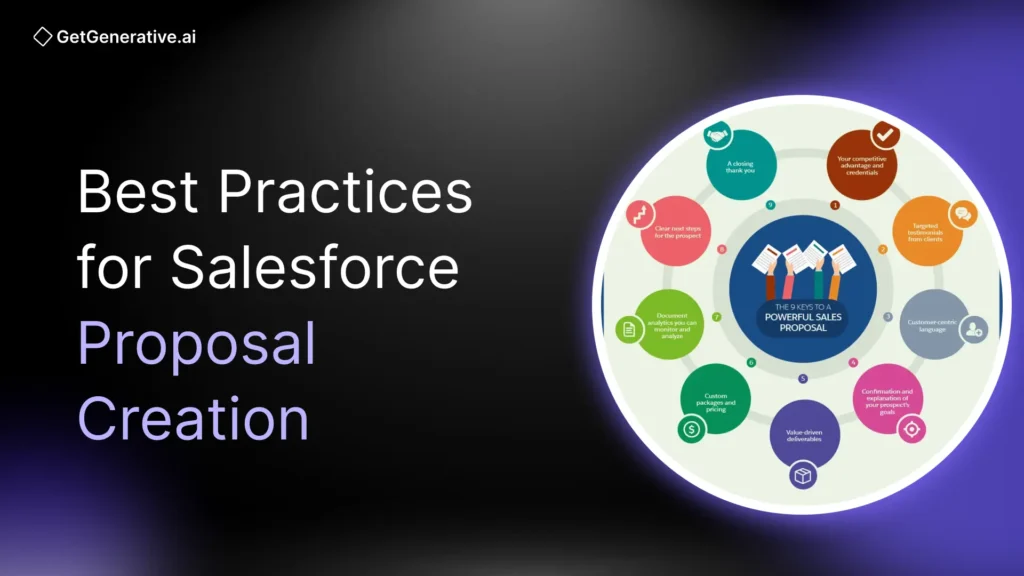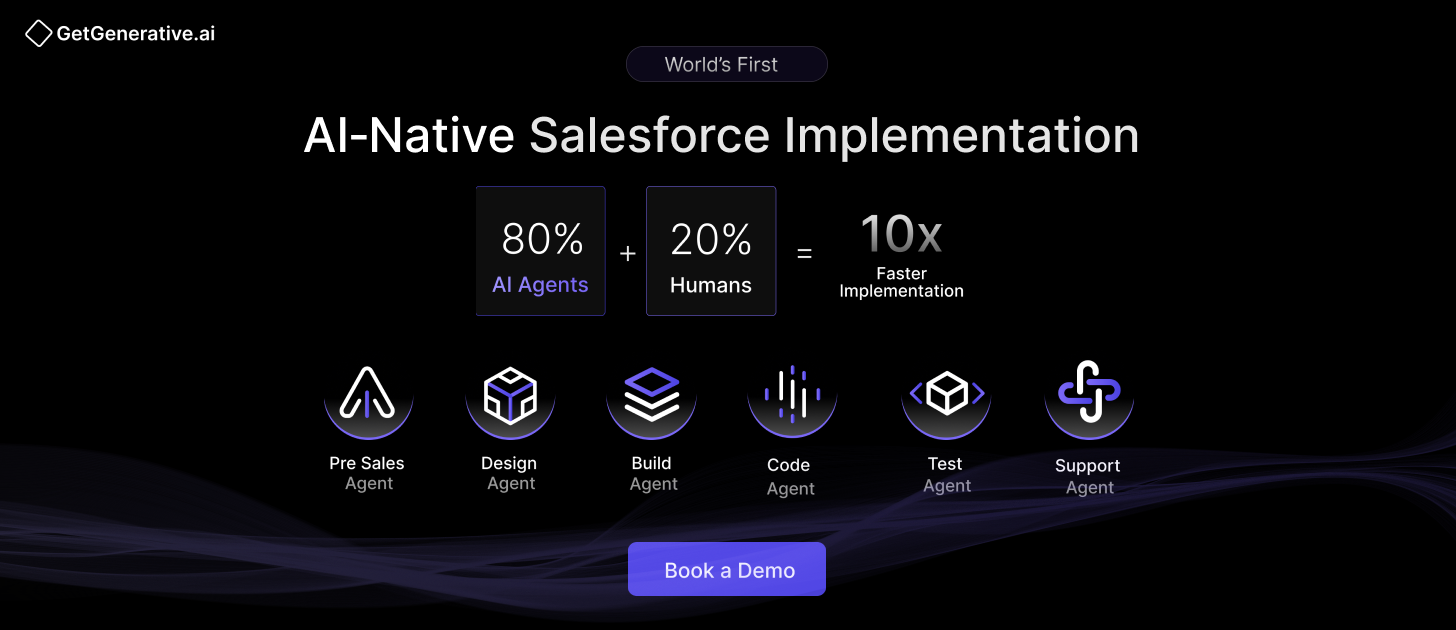Best Practices for Salesforce Proposal Creation
The speed, precision, and personalization of your proposal process can determine whether you win or lose a deal. With 81% of sales teams already experimenting with or fully implementing AI-powered solutions, and companies achieving up to 188% ROI improvements through advanced proposal automation, optimizing Salesforce proposal creation is no longer optional — it’s a strategic necessity.
The business case for modernization is clear:
- Efficiency gains – Companies implementing proposal automation report a 77% reduction in proposal creation time and 27% improvement in win rates.
- Fewer clicks, faster quotes – AI-powered quoting reduces manual steps by up to 87%.
- Competitive advantage – Businesses that respond to prospects first win 50% more deals, while teams without CPQ take 73% longer to produce quotes.
The move from manual workflows to intelligent automation represents both an opportunity and an imperative.
1. Building the Strategic Foundation
From CPQ to Revenue Cloud Advanced
Salesforce’s proposal creation capabilities have evolved from traditional CPQ to Revenue Cloud Advanced (RCA). With Salesforce CPQ entering End-of-Sale status in 2025, existing customers still retain support, but the platform’s strategic direction now centers on RCA — a native Einstein 1 solution with API-first architecture and agent-ready capabilities.
Revenue Cloud Advanced offers:
- Advanced product configuration with constraint-based logic
- AI-powered quoting agents for natural language generation
- Integrated contract lifecycle management without extra licensing
- Native billing, subscription management, and real-time asset tracking
- Automated renewals and revenue lifecycle management
This evolution enables faster configuration, better integration, and greater scalability for modern revenue models.
Market Position and Competitive Advantages
Salesforce holds a leading position in the CPQ and proposal automation market, with adoption rates as high as 80% in high-tech and manufacturing sectors. Companies using Salesforce solutions consistently report:
- 65–85% faster quote turnaround times
- 52% increase in sales productivity
- 15–45% uplift in cross-sell opportunities
- 40% fewer pricing/configuration errors
- 28% shorter sales cycles
These improvements directly translate to higher revenue velocity and stronger market positioning.
2. Core Best Practices for Salesforce Proposal Creation
Strategic Planning and Objective Setting
High-performing organizations treat proposal automation as a strategic initiative, not just a technology upgrade. Those achieving up to 147% ROI and $1M in annual benefits typically follow a structured planning framework that includes:
- Business case development – Quantify efficiency gains, revenue impact, and total cost of ownership.
- Stakeholder alignment – Ensure C-level sponsorship and cross-functional collaboration across sales, operations, and IT.
- Change management planning – Anticipate adoption challenges and develop targeted training and communication strategies.
Strong executive sponsorship is present in 85% of successful implementations, significantly reducing the risk of project failure.
Data Architecture and Quality Management
Data quality is the foundation of effective proposal automation — poor product catalogs, pricing inaccuracies, and duplicate customer records are among the top causes of CPQ failures.
Pre-implementation priorities should include:
- Auditing historical data for gaps and inconsistencies
- Standardizing product catalogs and pricing models
- Cleansing customer data and removing duplicates
- Mapping integrations for seamless data flows between systems
Ongoing governance should involve automated validation rules, regular audits, and dashboards that monitor data accuracy over time.
Technology Integration Strategy
A seamless integration between CRM and proposal automation tools ensures data accuracy and accelerates the sales cycle. API-first architectures allow for composable solutions that adapt to evolving business needs.
Integration best practices:
- Bidirectional sync – Keep customer, deal, and competitive data updated in real time between CRM and proposal systems.
- Workflow triggers – Automate proposal generation based on deal stage changes or customer activity.
- Approval routing – Auto-route documents to the right stakeholders based on deal size, industry, or complexity.
Advanced Configuration and Customization
Modern Salesforce proposal platforms support advanced configuration that reduces manual work while improving accuracy.
Configuration best practices:
- Build modular product architectures for flexible bundling
- Implement dynamic pricing rules for complex discount structures
- Use guided selling to help reps choose optimal solutions
- Apply real-time compatibility checks to prevent invalid configurations
For content, standardized templates can cut creation times dramatically while ensuring brand consistency. Companies with well-managed template libraries report 300–500% better knowledge-sharing effectiveness.
Also Read – Salesforce Proposal Creation With AI: Streamline & Win Deals
3. Performance Measurement and Optimization
Key Performance Indicators (KPIs)
Effective measurement ensures continuous improvement and validates ROI. Leading organizations track both operational efficiency and business impact:
Operational Efficiency Metrics
- Proposal creation time – Target a 77% reduction from baseline
- Quote accuracy – Achieve 95%+ accuracy through automated validations
- Approval cycle duration – Reduce by 70–85% with workflow automation
- Template utilization rates – Monitor adoption of standardized content
- Rep productivity – Measure output per sales rep over time
Business Impact Metrics
- Win rate – Aim for a 15–35% uplift post-implementation
- Average deal size – Track growth in contract values
- Sales cycle length – Reduce by 25–45%
- Customer satisfaction – Monitor proposal quality perception scores
- Competitive performance – Compare win rates against key rivals
Advanced Analytics
AI-powered analytics unlock deeper insights, including:
- Proposal success scoring based on historical deal data
- Machine learning–driven pricing recommendations
- Competitive win probability assessments
- Predictive content performance analysis
Combining these insights with A/B testing and industry benchmarking creates a closed feedback loop for ongoing optimization.
4. Emerging Technologies and Future Trends
AI in Proposal Management
AI integration is transforming proposal creation from a manual, template-driven process to a predictive, data-enriched workflow. Current capabilities include:
- Automated content generation – Natural language processing converts requirements into tailored proposals.
- Dynamic personalization – Adjusts messaging based on industry, persona, and past interactions.
- Compliance automation – Instantly flags non-compliant language or missing terms.
- Predictive intelligence – Scores deals, suggests pricing strategies, and identifies competitive positioning.
With 81% of sales teams already adopting AI tools, early movers are gaining an edge in speed, accuracy, and personalization.
Platform Evolution
Salesforce’s Revenue Cloud Advanced aligns with broader market trends toward:
- API-first architectures for composable business solutions
- Native AI capabilities embedded into the revenue lifecycle
- Constraint-based product configuration for greater flexibility
- Unified quote-to-cash processes without the need for multiple point solutions
For organizations with complex revenue models and multi-channel selling strategies, migrating to RCA can unlock significant scalability and automation advantages.
5. Implementation Strategy and Change Management
Phased Deployment
A phased approach minimizes disruption and increases adoption:
Phase 1: Foundation (Months 1–3)
- Conduct requirements analysis
- Cleanse and standardize data
- Form cross-functional teams
- Define integration architecture
Phase 2: Core Deployment (Months 3–6)
- Configure product catalogs, pricing, and templates
- Automate key workflows
- Run user acceptance testing with real scenarios
Phase 3: Advanced Rollout (Months 6–9)
- Activate AI-driven features
- Expand integrations to partner systems
- Optimize based on analytics and user feedback
Driving Adoption
Change management is critical. Best practices include:
- Role-based training tailored to each function
- Hands-on workshops using real proposal scenarios
- Early engagement of influential sales team members
- Sharing quick-win success stories to build momentum
Also Read – Salesforce Proposal Creation with AI Agents
6. Risk Management and Compliance
Implementation Risks
Common pitfalls include:
- Poor data quality leading to pricing/configuration errors
- Overly complex integrations causing workflow disruption
- Low adoption due to inadequate training
- Scope creep driving delays and cost overruns
Mitigation strategies: phased rollouts, end-to-end testing, strong executive sponsorship, and clearly defined success metrics.
Compliance and Security
Proposal automation must align with data privacy laws (e.g., GDPR) and industry-specific regulations (e.g., SOX, HIPAA). Salesforce platforms offer built-in compliance features such as:
- Audit trails for regulatory review
- Role-based access controls
- Automated document retention and versioning
7. Executive Takeaways and Next Steps
The ROI case for Salesforce proposal automation is compelling:
- 77% faster proposal creation
- 27% higher win rates
- 188% improvement in ROI
- Nearly $1 million in annual benefits for mature implementations
Action Plan:
- Next 30 days – Audit current proposal processes, assess data quality, and engage vendors for tailored demos.
- Next 90 days – Build a business case, develop a phased roadmap, and secure executive sponsorship.
- Long term – Align platform capabilities with 5-year revenue strategy, integrating AI and multi-channel capabilities for sustained advantage.
Also Read – Salesforce Implementation Proposal Checklist
Final Thoughts
The future of Salesforce proposal creation is intelligent, automated, and insight-driven. Organizations that invest in world-class automation, powered by AI and aligned with strategic goals, will not only accelerate deal cycles but also create a sustainable competitive advantage in increasingly fast-moving markets.
At GetGenerative.ai, we’ve reimagined Salesforce implementation—built from the ground up with AI at the core. This isn’t legacy delivery with AI added on. It’s a faster, smarter, AI-native approach powered by our proprietary platform.
👉 Explore our Salesforce AI consulting services




